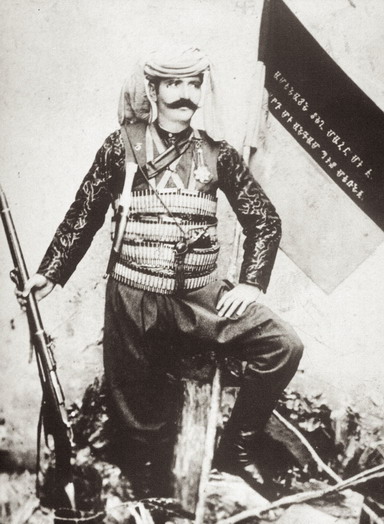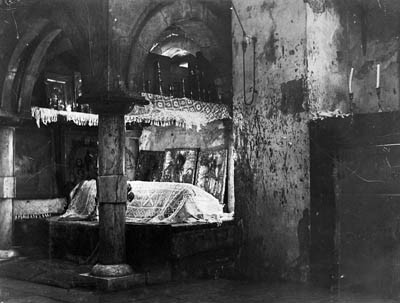|
Makhluto
Makhluto ( hy, Մախլուտո; 1875–1956), born Smbat Boroyan (), also known as General Smbat, was an Armenian fedayee commander during the Armenian national movement. He was known for his battles alongside General Andranik Ozanian. Early Age Smbat was born in Western Armenian city of Mush in 1875. When he was a child, his parents sent him to Saint Karapet Monastery to receive a formal education. During this time, Smbat became acquainted with the " Armenian Question". He became inspired by the stories he heard of Armenian guerrillas (feedayis) taking arms to defend their homeland. In the mid-1880s, Smbat and his friend Levon escaped from school to join the feedayis. He joined the Vardanantz group when aged 15. One of his first tasks was to move their bags and rifles because they did not initially trust him with a gun. Early Revolutionary Activities Makhluto was present throughout most of the major battles that took place in the Van- Taron region in the 1890s. He fought ... [...More Info...] [...Related Items...] OR: [Wikipedia] [Google] [Baidu] |
Muş
Muş (; hy, Մուշ; ku, Mûş) is a city and the provincial capital of Muş Province in Turkey. Its population is mostly Kurds. Etymology Various explanations of the origin of Muş's name exist. Its name is sometimes associated with the Armenian word ''mshush'' ( hy, մշուշ), meaning fog, explained by the fact that the town and the surrounding plain are frequently covered in fog in the mornings. The 17th-century explorer Evliya Çelebi relates a myth where a giant mouse created by Nemrud (Nimrod) destroys the city and its inhabitants, after which the city was named Muş (''muš'' means "mouse" in Persian).. Others have proposed a connection with the names of different ancient Anatolian peoples, the Mushki or the Mysians, or the toponyms ''Mushki'' and ''Mushuni'' mentioned in Assyrian and Hittite sources, respectively. History Ancient and medieval The date of foundation of Mush is unknown, although a settlement is believed to have been around by the time of Menua, ... [...More Info...] [...Related Items...] OR: [Wikipedia] [Google] [Baidu] |
Armenian–Azerbaijani War (1918–1920)
The Armenian-Azerbaijani war (1918–1920); ; russian: Армяно-азербайджанская война, translit=Armi͡ano-azerbaĭdzhanskai͡a voĭna. was a conflict that took place in the South Caucasus in regions with a mixed Armenian- Azerbaijani population, broadly encompassing what are now modern-day Azerbaijan and Armenia. It began during the final months of World War I and ended with the establishment of Soviet rule. The conflict took place against the backdrop of the Russian Civil War and the partition of the Ottoman Empire. Mutual territorial claims, made by the newly formed Azerbaijan Democratic Republic and Republic of Armenia, led to their respective support for Azerbaijani and Armenian militias in the disputed territories. Armenia fought against Azerbaijani militias in the Erivan Governorate of the former Russian Empire, while Azerbaijan fought Armenian claims to the Karabakh region. The war was characterized by outbreaks of massacres and ethnic cleansing ... [...More Info...] [...Related Items...] OR: [Wikipedia] [Google] [Baidu] |
Arshak Gafavian
Arshak Gavafian, better known by his '' nom de guerre'' Keri (1858 – 15 May 1916), was an Armenian fedayee military commander and member of the Armenian Revolutionary Federation.Antranig Chalabian, General Andranik and the Armenian Revolutionary Movement - Page 583 Biography Arshak Gavafian was born in Erzurum. He graduated from the local Armenian school. Gavafian had soon taken part in Armenian resistance activity. In 1895, during the Hamidian massacres in Erzurum, Gavafian led an armed group to protect Armenian people in the region and soon became their spiritual leader.K. S. Khudaverdyan, Armenian issue: Encyclopedia, 1991 - 348st; Gavafian moved to Sasun in 1903 and took part in the 1904 Sasun uprising. After moving to Vaspurakan, he was one of the organizers of the Armenian self-defense of Zangezur (in particular, Angeghakot) during the Armenian–Tatar massacres. In the following years he took part in the Persian Constitutional Revolution from 1908 to 1912 and was ... [...More Info...] [...Related Items...] OR: [Wikipedia] [Google] [Baidu] |
Andranik Pasha
Andranik Ozanian, commonly known as General Andranik or simply Andranik;. Also spelled Antranik or Antranig 25 February 186531 August 1927), was an Armenian military commander and statesman, the best known '' fedayi'' and a key figure of the Armenian national liberation movement. From the late 19th century to the early 20th century, he was one of the main Armenian leaders of military efforts for the independence of Armenia. He became active in an armed struggle against the Ottoman government and Kurdish irregulars in the late 1880s. Andranik joined the Armenian Revolutionary Federation (Dashnaktustyun) party and, along with other '' fedayi'' (militias), sought to defend the Armenian peasantry living in their ancestral homeland, an area known as Western (or Turkish) Armeniaat the time part of the Ottoman Empire. His revolutionary activities ceased and he left the Ottoman Empire after the unsuccessful uprising in Sasun in 1904. In 1907, Andranik left Dashnaktustyun because h ... [...More Info...] [...Related Items...] OR: [Wikipedia] [Google] [Baidu] |
Kevork Chavoush
Kevork Ghazarian ( hy, Գէորգ Ղազարեան; 1870 – 28 May 1907), commonly known as Kevork Chavush or Gevorg Chaush ( hy, Գէորգ Չաւուշ or Գևորգ Չաուշ), was an Armenian '' fedayee'' leader in the Ottoman Empire and a member of the Armenian Revolutionary Federation. Kevork Chavush attained a legendary status during his lifetime for his extraordinary daring and valor in defense of the Armenian peasantry against harassment by marauding Turkish and Kurdish forces. He was the undisputed leader of Armenian revolutionary forces in the region of Taron-Sasun from 1904 until his death in 1907 after being wounded in a battle with the Ottoman army. Kevork's actions earned him the moniker "Lion of the Mountains" ( hy, Սարերու Ասլան). Early life Kevork Chavush was born Kevork Ghazarian (although his surname is given as Adamian or Melkonian in various sources) to a family of hunters in the region of Sasun, in the village of Mktink of the Psank (Psana ... [...More Info...] [...Related Items...] OR: [Wikipedia] [Google] [Baidu] |
Taron (historic Armenia)
Taron ( hy, Տարօն; Western Armenian pronunciation: ''Daron''; el, Ταρών, ''Tarōn''; la, Taraunitis) was a canton of the Turuberan province of Greater Armenia, roughly corresponding to the Muş Province of modern Turkey. Early Middle Ages The main source on the principality's history during the Early Middle Ages is the ''History of Taron'', a relatively short "historical" romance in five parts, purporting to describe significant events occurring in the district of Taron during the Byzantine–Sassanid Wars when the Sassanid emperor was Khosrau II (590-628). During Khosrau's reign, Taron was frequently invaded by the Persians. The ''History'' describes the actions of five generations of Mamikonians (Taron's princely house), in defending and avenging the district. Each section or cycle of the story is devoted to the exploits of one of the defenders: Mushegh, Vahan, Smbat, his son Vahan Kamsarakan, and the latter's son Tiran. The heroes are at times superhumanly brave o ... [...More Info...] [...Related Items...] OR: [Wikipedia] [Google] [Baidu] |
GENERAL ANDRANIK AND HIS FEDAYI COMMANDERS
A general officer is an officer of high rank in the armies, and in some nations' air forces, space forces, and marines or naval infantry. In some usages the term "general officer" refers to a rank above colonel."general, adj. and n.". OED Online. March 2021. Oxford University Press. https://www.oed.com/view/Entry/77489?rskey=dCKrg4&result=1 (accessed May 11, 2021) The term ''general'' is used in two ways: as the generic title for all grades of general officer and as a specific rank. It originates in the 16th century, as a shortening of '' captain general'', which rank was taken from Middle French ''capitaine général''. The adjective ''general'' had been affixed to officer designations since the late medieval period to indicate relative superiority or an extended jurisdiction. Today, the title of ''general'' is known in some countries as a four-star rank. However, different countries use different systems of stars or other insignia for senior ranks. It has a NATO ... [...More Info...] [...Related Items...] OR: [Wikipedia] [Google] [Baidu] |
Saint Karapet Monastery
Surb Karapet Monastery of Mush ( hy, Մշո Սուրբ Կարապետ վանք, ''Msho Surb Karapet vank'', or ''Surpgarabet Manastırı''. also known by #Names, other names) was an Armenian Apostolic Church, Armenian Apostolic monastery in the historic province of Taron (historic Armenia), Taron, about northwest of Muş, Mush (Muş), in present-day eastern Turkey. ''Surb Karapet'' translates to "Precursor (religion), Holy Precursor" and refers to John the Baptist, whose remains are believed to have been stored at the site by Gregory the Illuminator in the early fourth century. The monastery subsequently served as a stronghold of the Mamikonians—the princely house of Taron, who claimed to be the holy warriors of John the Baptist, their patron saint. It was expanded and renovated many times in later centuries. By the 20th century, it was a large fort-like enclosure with four chapels. Historically, the monastery was the religious center of Taron and was a prominent pilgrimage si ... [...More Info...] [...Related Items...] OR: [Wikipedia] [Google] [Baidu] |
Andranik Ozanian
Andranik Ozanian, commonly known as General Andranik or simply Andranik;. Also spelled Antranik or Antranig 25 February 186531 August 1927), was an Armenians, Armenian military commander and statesman, the best known ''Armenian fedayi, fedayi'' and a key figure of the Armenian national movement, Armenian national liberation movement. From the late 19th century to the early 20th century, he was one of the main Armenian leaders of military efforts for the independence of Armenia. He became active in an armed struggle against the Ottoman Empire, Ottoman government and Kurdish irregulars in the late 1880s. Andranik joined the Armenian Revolutionary Federation (Dashnaktustyun) party and, along with other ''Armenian fedayi, fedayi'' (militias), sought to defend the Armenian peasantry living in their ancestral homeland, an area known as Western Armenia, Western (or Turkish) Armeniaat the time part of the Ottoman Empire. His revolutionary activities ceased and he left the Ottoman Empi ... [...More Info...] [...Related Items...] OR: [Wikipedia] [Google] [Baidu] |
Armenian National Movement
The Armenian national movement ( hy, Հայ ազգային-ազատագրական շարժում ''Hay azgayin-azatagrakan sharzhum'') included social, cultural, but primarily political and military movements that reached their height during World War I and the following years, initially seeking improved status for Armenians in the Ottoman and Russian Empires but eventually attempting to achieve an Armenian state. Influenced by the Age of Enlightenment and the rise of nationalism under the Ottoman Empire, the Armenian national movement developed in the early 1860s. Its emergence was similar to that of movements in the Balkan nations, especially the Greek revolutionaries who fought the Greek War of Independence. The Armenian élite and various militant groups sought to defend the mostly rural Christian Armenian population of the eastern Ottoman Empire from banditry and abuses by Muslims, but the ultimate goal was to push for reforms in the six Armenian-populated vilayets of the ... [...More Info...] [...Related Items...] OR: [Wikipedia] [Google] [Baidu] |
Christopher J
Christopher is the English version of a Europe-wide name derived from the Greek name Χριστόφορος (''Christophoros'' or '' Christoforos''). The constituent parts are Χριστός (''Christós''), "Christ" or "Anointed", and φέρειν (''phérein''), "to bear"; hence the "Christ-bearer". As a given name, 'Christopher' has been in use since the 10th century. In English, Christopher may be abbreviated as "Chris", "Topher", and sometimes " Kit". It was frequently the most popular male first name in the United Kingdom, having been in the top twenty in England and Wales from the 1940s until 1995, although it has since dropped out of the top 100. The name is most common in England and not so common in Wales, Scotland, or Ireland. People with the given name Antiquity and Middle Ages * Saint Christopher (died 251), saint venerated by Catholics and Orthodox Christians * Christopher (Domestic of the Schools) (fl. 870s), Byzantine general * Christopher Lekapenos (died 931) ... [...More Info...] [...Related Items...] OR: [Wikipedia] [Google] [Baidu] |





